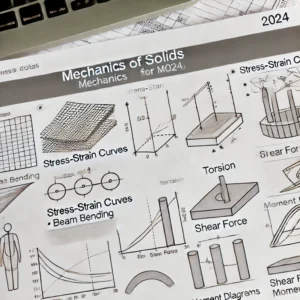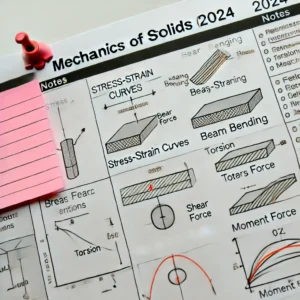Here you can download the Free lecture Notes of Mechanics of Solids Pdf Notes – MOS Pdf Notes materials with multiple file links to download. Mechanics of Solids Notes Pdf – MOS Notes Pdf book starts with the topics Elasticity and plasticity – Types of stresses & strains–Hooke’s law – stress – strain diagram for mild steel.

Mechanics of Solids Notes pdf – MOS Pdf Notes
The Mechanics of Solids Pdf Notes – MOS Pdf Notes
Mechanics of Solids Notes pdf – MS pdf notes – MS notes pdf file to download are listed below please check it –
Latest Material Links
Complete Notes
Link – Complete Notes
Unit 1
Link – Unit 1 Notes
Unit 2
Link – Unit 2 Notes
Unit 3
Link – Unit 3 Notes
Unit 4
Link – Unit 4 Notes
Unit 5
Link – Unit 5 Notes
Old Material Links
Complete Notes
Link: Complete Notes
Unit 1
Link: Unit 1 Notes
Unit 2
Link: Unit 2 Notes
Unit 3
Link: Unit 3 Notes
Unit 4
Link: Unit 4 Notes
Unit 5
Link: Unit 5 Notes
Note :- These notes are according to the R09 Syllabus book of JNTU. In R13 and R15,8-units of R09 syllabus are combined into 5-units in R13 and R15 syllabus. If you have any doubts please refer to the JNTU Syllabus Book.
Mechanics of Solids Notes PDF – MOS Notes PDF Lecture Notes for B. Tech (2025) – JNTUH
Mechanics of Solids (MOS) Notes PDF are an essential resource for B.Tech students, particularly those studying under the JNTUH curriculum. This subject covers the fundamentals of solid mechanics, which are crucial for understanding how materials respond to various forces and stresses. The MOS Notes PDF provides detailed insights into elasticity, plasticity, shear force, bending moments, and much more. Below, we will explore the content of these notes, focusing on what each unit covers, why these topics are important, and how students can best utilize this material for their academic success.
Mechanics of Solids Notes, PDF | MOS B. Tech (2025) JNTUH
Description: The Mechanics of Solids notes (MOS Notes PDF) are crucial for B.Tech students at JNTUH. These notes offer a structured approach to learning the fundamental principles of solid mechanics. The content is aligned with the JNTUH syllabus, making it an essential tool for students preparing for exams and assignments.
Solid mechanics is a fundamental branch of engineering that deals with the behavior of solid materials under various loading conditions. This subject is crucial for civil, mechanical, and aerospace engineering students as it lays the groundwork for understanding how structures and materials behave when subjected to forces. The MOS Notes PDF covers a wide range of topics, from basic stress-strain relationships to advanced concepts like deflection of beams and analysis of pin-jointed frames.
Mechanics of Solids Notes | PDF, Syllabus, Books | B.Tech (2025)
Overview: The MOS Notes PDF provides a detailed overview of solid mechanics, offering insights into the behavior of materials under different types of loads. The notes are divided into several units, each focusing on specific aspects of solid mechanics, ensuring that students gain a thorough understanding of the subject.
Solid mechanics is not just about understanding the theoretical aspects; it also involves applying these concepts to real-world problems. Whether it’s designing a bridge, a building, or any other structure, the principles learned in this subject are applied to ensure safety, reliability, and efficiency.
The following topics are covered in Mechanics of Solids handwritten Notes:
Unit 1: Simple Stresses & Strains
- Elasticity and Plasticity: This section introduces the concepts of elasticity and plasticity, which describe how materials deform and recover under various loads.
- Types of Stresses & Strains: Understanding the different types of stresses (tensile, compressive, shear) and strains (linear, lateral, volumetric) is crucial for analyzing material behavior.
- Hooke’s Law: A fundamental principle that describes the linear relationship between stress and strain in elastic materials.
- Stress-Strain Diagram for Mild Steel: This diagram is essential for understanding the behavior of mild steel under increasing loads, highlighting the elastic limit, yield point, and ultimate tensile strength.
- Working Stress & Factor of Safety: These concepts are vital for designing structures that can safely withstand applied loads without failure.
- Poisson’s Ratio & Volumetric Strain: These parameters describe the deformation in directions perpendicular to the applied load.
- Elastic Moduli & Relationships: Understanding Young’s modulus, shear modulus, and bulk modulus, and their interrelationships is crucial for material characterization.
- Bars of Varying Section & Composite Bars: This section covers the analysis of bars with varying cross-sections and composite bars made of different materials.
- Temperature Stresses: Analyzes the stresses induced in materials due to temperature changes, which is critical in many engineering applications.
- Strain Energy & Resilience: These concepts describe the energy stored in materials under load and their ability to absorb energy without permanent deformation.
- Gradual, Sudden, Impact, and Shock Loadings: Understanding the effects of different loading rates on materials is essential for designing structures that can withstand dynamic forces.
Unit 2: Shear Force and Bending Moment
- Definition of Beam: Introduces the concept of a beam as a structural element subjected to transverse loads.
- Types of Beams: Covers the different types of beams, including cantilever, simply supported, and overhanging beams.
- Concept of Shear Force and Bending Moment: These concepts are fundamental for analyzing the internal forces and moments within a beam.
- Shear Force and Bending Moment Diagrams: This section explains how to construct S.F. and B.M. diagrams for various types of beams subjected to point loads, uniformly distributed loads (u.d.l.), and uniformly varying loads.
- Point of Contra Flexure: Identifies the point in a beam where the bending moment changes sign, which is critical for understanding beam behavior under load.
- Relation Between S.F., B.M., and Rate of Loading: Explains the mathematical relationship between shear force, bending moment, and the rate of loading at any section of a beam.
Unit 3: Flexural Stresses
- Theory of Simple Bending: This theory describes how beams bend under transverse loads and the assumptions made in the analysis.
- Derivation of Bending Equation: The bending equation M/I=f/y=E/RM/I = f/y = E/R relates the bending moment (M), section modulus (I), bending stress (f), and radius of curvature (R).
- Neutral Axis: The line in the cross-section of a beam where the stress is zero during bending.
- Determination of Bending Stresses: This section covers how to calculate the bending stresses in beams of different cross-sections.
- Section Modulus: The section modulus is a geometric property that plays a crucial role in determining the strength of a beam.
- Design of Simple Beam Sections: Covers the design of beams with various cross-sections, such as rectangular, circular, I-beams, T-beams, angle, and channel sections, to withstand specified loads.
Unit 4: Shear Stresses
- Derivation of Shear Stress Formula: This section derives the formula for calculating shear stresses in beams subjected to transverse loads.
- Shear Stress Distribution: Covers the distribution of shear stresses across different cross-sections, including rectangular, circular, and triangular sections, as well as I-beams and T-beams.
Unit 5: Analysis of Pin-Jointed Plane Frames
- Pin-Jointed Plane Frames: Introduces the concept of pin-jointed frames, which are structures where members are connected by pins, allowing rotation but not translation.
- Method of Joints: A technique for determining the forces in each member of a truss by considering the equilibrium of the joints.
- Method of Sections: An alternative method for analyzing trusses, where a section of the truss is isolated, and the forces in the cut members are determined.
- Analysis of Various Types of Trusses: Covers the analysis of cantilever trusses, simply supported trusses, and other common truss configurations using the methods of joints, sections, and tension coefficient methods.
Unit 6: Deflection of Beams
- Bending into a Circular Arc: Describes the deflection of beams as they bend into a circular arc under transverse loads.
- Slope, Deflection, and Radius of Curvature: Covers the mathematical relationships between the slope, deflection, and radius of curvature of a beam.
- Differential Equation for the Elastic Line: Derives the differential equation that describes the elastic line (deflection curve) of a beam.
- Double Integration and Macaulay’s Methods: These methods are used to solve the differential equation and determine the slope and deflection of beams.
- Determination of Slope and Deflection: Applies the double integration and Macaulay’s methods to cantilever and simply supported beams subjected to various loads, including point loads and uniformly distributed loads (U.D.L.).
- Mohr’s Theorems: Mohr’s theorems provide an alternative approach to determining the slope and deflection in beams.
- Moment Area Method: A graphical method for determining the deflection of beams by analyzing the area under the bending moment diagram.
Unit 7: Thin Cylinders
- Thin Seamless Cylindrical Shells: Describes the behavior of thin cylindrical shells under internal pressure.
- Longitudinal and Circumferential Stresses: Derives the formulas for calculating longitudinal and circumferential stresses in thin cylinders.
- Hoop Stress: The stress acting circumferentially in the walls of a cylinder subjected to internal pressure.
- Volumetric Strains: Covers the changes in volume and dimensions (diameter, length) of thin cylinders under internal pressure.
- Riveted Boiler Shells: Discusses the design and analysis of riveted boiler shells, a common application of thin cylinders.
- Thin Spherical Shells: Extends the analysis to spherical shells, deriving the formulas for stresses and strains.
Unit 8: Thick Cylinders
- Lame’s Equation: Derives Lame’s equations for analyzing thick cylinders subjected to internal and external pressures.
- Cylinders Subjected to Inside & Outside Pressures: Discusses the stresses and strains in thick-walled cylinders subjected to internal and external pressures.
- Compound Cylinders: Analyzes compound cylinders, which consist of two or more concentric cylinders subjected to different pressures.
Reference
- Strength of Materials – By Jindal, Umesh Publications.
- Analysis of Structures by Vazirani and Ratwani.
- Mechanics of Structures Vol-III by S.B. Junnarkar.
- Strength of Materials by S. Timoshenko.
- Strength of Materials by Andrew Pytel and Ferdinand L. Singer, Longman.
Textbooks
- Strength of Materials by Bhavikatti, Lakshmi Publications.
- Solid Mechanics by Popov.
MOS Notes PDF from JNTUH
These notes are meticulously crafted for students of JNTUH and are aligned with the university’s syllabus, making them indispensable for exam preparation. The notes are comprehensive and easy to understand, ensuring that students grasp even the most complex concepts with ease.
Always Choose Smartzworld to download MOS Notes PDF
Smartzworld is your go-to source for downloading the latest and most accurate Mechanics of Solids Notes PDF. With its user-friendly interface and organized content, Smartzworld makes it easy for students to access the study material they need to excel in their exams.
Benefits of FREE MOS Handwritten Notes PDF
- Comprehensive Coverage: These notes cover all the units and topics in the JNTUH syllabus, ensuring that students have access to all the information they need.
- Easy to Download: The notes are available for download through direct links, making it convenient for students to access them.
- Up-to-Date Material: The notes are regularly updated to reflect the latest syllabus and exam patterns, ensuring that students are always prepared.
- Free Access: All the notes are available for free, making high-quality study material accessible to all students.
FAQs
Q1. Where can I download the Mechanics of Solids Notes PDF?
You can download the notes from the provided links for each unit or the complete set from Smartzworld.
Q2. How to download the MOS Notes PDF?
Click on the provided links to access and download the notes.
Q3. How many modules are covered in the MOS Notes PDF?
The MOS Notes PDF covers eight modules, corresponding to the eight units in the syllabus.
Q4. Topics Covered in MOS Notes PDF?
The notes cover simple stresses and strains, shear force and bending moment, flexural stresses, shear stresses, analysis of pin-jointed plane frames, deflection of beams, thin cylinders, and thick cylinders.
Q5. Where can I get the complete MOS Handwritten Notes PDF FREE Download?
You can download the complete handwritten notes PDF for free from Smartzworld.
Q6. How to download MOS Handwritten Notes PDF?
Visit the provided links on Smartzworld, and you can easily download the handwritten notes.
Q7. How to Download FREE MOS Notes PDF?
Simply click on the download links provided for each unit on Smartzworld to access the free PDF notes.
Follow us on Facebook and Support us with your Like


